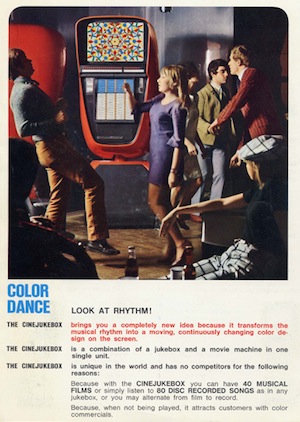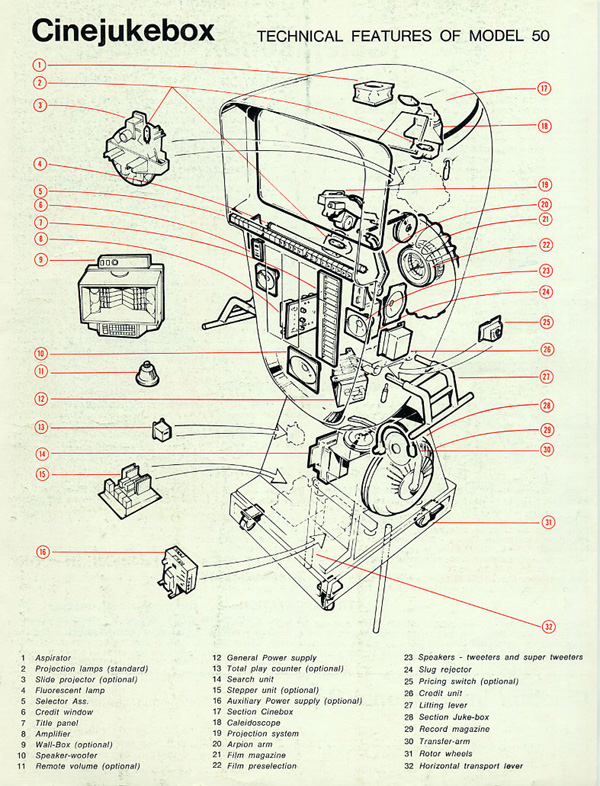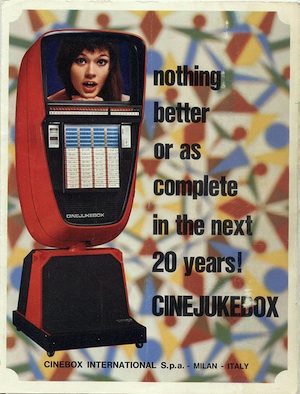The above image has been on my mind since I first chanced on it a few days ago. The retro-futuristic Ferrari-red semi-egg shaped oddity in this dance club is the Cinejukebox, a deluxe version of the Cinebox, an Italian coin-operated jukebox that played short colour 16mm musical films. The Cinebox, invented in Rome in the late 1950’s and mass-manufactured in Milan during the 1960’s is less well known than the French-produced Scopitone. A recently published book, Canzoni da guardare/Songs to See: Cinebox & Scopitone [1] by Michele Bovi provides evidence the Cinebox has precedence.
Several things fascinate me about the image, taken from a promotional brochure for the Cinejukebox. What initially caught my attention is the kaleidoscopic display on the monitor, the blue sub-title, Color Dance, and the injunctive Look at Rhythm, followed by the claim:
The Cinejukebox brings you to a completely new idea because it transforms the musical rhythm into a moving, continuously changing color design on the screen.
It seems that the Cinejukebox contained a caleidoscopic [sic] projection unit, with separate 12V 100W quartz-iodine lamp. The box also contained separate lamps for the 16mm projector and an optional still projector for showing promotional slides when neither musical films nor records are selected. From the technical brochure:
The amplifier also is equipped with a section for excitation of the visualizer of music during the playing of records, with action which is independent of the volume level generated by the sound control system.
In other words, this is a music visualization system functioning, not acoustically, but most likely via an electro-mechanical actuator driven by the electrical audio waveform. The Cinejukebox was a mid-1960’s version of the earlier Cinebox,with functionality added to allow playing (vinyl) records, like a jukebox. The kaleidoscopic visualizer added graphical activity to the Cinejukebox screen when using jukebox mode.
An aesthetic aspect of the Cinejukebox interests me. While I have not yet been able to see what it looked like in action, the kaleidoscopic visual display is reminiscent of some of John and James Whitney‘s films from the same era (early to mid-1960’s). See, for example, James Whitney’s 1966 16mm short film Lapis. The Whitneys’ experimental animations were (and are) considered to be the height of avant-garde cinema for the day. By contrast, the Scopitone and Cinebox were used to circulate some of the most kitsch visual media humanity has ever seen (more about this in future post). Susan Sontag’s famous essay Notes on Camp [2] described Scopitones as part of a camp canon. How did it come to pass that what was aesthetically experimental media, for its time, made it contemporaneously into technology aimed at mass consumption? In brief, the Cinejukebox appears to be Scopitones and the Whitneys in the same screaming red box. Could this reflect the futuristic techno-utopianism current during the early 1960’s? Was the kaleidoscopic music visualizer evaluated positively by viewers and what impact has it had, if any, on later soni-graphical experiments and technologies? Were there precedents for this kind of audio driven kaleidoscopic display? Further research would be necessary to provide answers for these questions.
Finally, the kaleidoscopic visualizer seems to be related, in concept at least, to an interactive system, the Iamascope, developed by my colleague Prof. Sidney Fels, in the late 1990’s and shown in the Millenium Dome in London during the festivities for the year 2000-2001. It was also demonstrated at NIME-01 held at the Experience Music Project, Seattle.
The pessimist might conclude nothing under the sun is new, while the optimist might answer interesting ideas never die.
[1] Michele Bovi, Canzoni da Guardare/Songs to See: Cinebox & Scopitone (2007). (Accessed 15.02.2012.)
[2] Susan Sontag, Notes on Camp, In: Against Interpretation and Other Essays. New York, Dell (1967).



